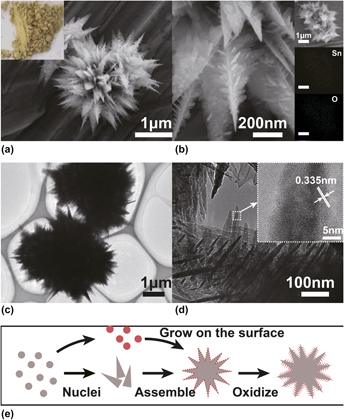Crossref Citations
This article has been cited by the following publications. This list is generated based on data provided by
Crossref.
Lim, Taekyung
Jung, Sang‐Mi
Kang, Youngsoo
and
Ju, Sanghyun
2019.
Light‐Liquid Selective Filter‐Mounted Nanowire‐Networked Polyurethane Fiber for an Ultraviolet Sensor.
Advanced Materials Interfaces,
Vol. 6,
Issue. 19,
Kamarulzaman, Norlida
Abdul Aziz, Nor Diyana
Kasim, Muhd Firdaus
Chayed, Nor Fadilah
Yahaya Subban, Ri Hanum
and
Badar, Nurhanna
2019.
Anomalies in wide band gap SnO2 nanostructures.
Journal of Solid State Chemistry,
Vol. 277,
Issue. ,
p.
271.
Zeng, Qinghao
Cui, Yanfa
Zhu, Lianfeng
and
Yao, Youwei
2020.
Increasing oxygen vacancies at room temperature in SnO2 for enhancing ethanol gas sensing.
Materials Science in Semiconductor Processing,
Vol. 111,
Issue. ,
p.
104962.
Zhao, Yanping
Liu, Yuxiang
Ma, Yixuan
Li, Yuehua
Zhang, Jianhong
Ren, Xingping
Li, Cheng
Zhao, Jingchang
Zhu, Jing
and
Zhao, Heyun
2020.
Hollow Pentagonal-Cone-Structured SnO2 Architectures Assembled with Nanorod Arrays for Low-Temperature Ethanol Sensing.
ACS Applied Nano Materials,
Vol. 3,
Issue. 8,
p.
7720.
Xu, Lei
Ge, Meiying
Zhang, Fang
Huang, Haijun
Sun, Yan
and
He, Dannong
2020.
Nanostructured of SnO2/NiO composite as a highly selective formaldehyde gas sensor.
Journal of Materials Research,
Vol. 35,
Issue. 22,
p.
3079.
Han, Yuqi
Wei, Miaomiao
Qu, Shuangyan
Zhong, Ming
Han, Lijuan
Yang, Haidong
Liu, Yang
Su, Bitao
and
Lei, Ziqiang
2020.
Ag@AgCl quantum dots embedded on Sn3O4 nanosheets towards synergistic 3D flower-like heterostructured microspheres for efficient visible-light photocatalysis.
Ceramics International,
Vol. 46,
Issue. 15,
p.
24060.
Gao, Liping
Fu, Hao
Zhu, Jiejun
Wang, Junhai
Chen, Yuping
and
Liu, Hongjie
2020.
Synthesis of SnO2 nanoparticles for formaldehyde detection with high sensitivity and good selectivity.
Journal of Materials Research,
Vol. 35,
Issue. 16,
p.
2208.
Maheswari, S.
Karunakaran, M.
Hariprasad, K.
Kasirajan, K.
Chandrasekar, L. Bruno
Alshahrani, T.
Shkir, Mohd.
and
AIFaify, S.
2021.
Enhanced room-temperature ammonia vapor-sensing activity of nebulizer spray pyrolysis fabricated SnO2 thin films: an effect of Er doping.
Journal of Materials Research,
Vol. 36,
Issue. 3,
p.
657.
Srivastava, Meenakshi
Jaiswal, Piyush
and
Singh, Narendra
2021.
Proceedings of 28th National Conference on Condensed Matter Physics.
Vol. 269,
Issue. ,
p.
35.
Pazouki, Sepideh
and
Memarian, Nafiseh
2021.
Effects of Hydrothermal temperature on the physical properties and anomalous band gap behavior of ultrafine SnO2 nanoparticles.
Optik,
Vol. 246,
Issue. ,
p.
167843.
Khajuee, Sahar
and
Memarian, Nafiseh
2021.
Hydrothermal synthesis of ultrafine SnO2 nanospheres: effect of reaction time on physical properties.
The European Physical Journal Plus,
Vol. 136,
Issue. 5,
Shihabudeen, P. K.
and
Roy Chaudhuri, Ayan
2021.
Ethanol sensing properties of nitrogen doped In2O3 thin films.
Journal of Materials Research,
Vol. 36,
Issue. 7,
p.
1561.
Zhao, Jiguang
Tan, Zejie
Tian, Bing
Zhao, Liang
Zhao, Fan
and
Wang, Hairong
2024.
Low Concentration C2H2 Detection by NiO/SnO2 Nanostructured Heterojunction Based MEMS Sensor.
Journal of The Electrochemical Society,
Vol. 171,
Issue. 12,
p.
127503.
Molahalli, Vandana
Soman, Gowri
Bhat, Vinay S.
Shetty, Apoorva
Alodhayb, Abdullah
and
Hegde, Gurumurthy
2024.
Zinc oxide/tin oxide nanoflower-based asymmetric supercapacitors for enhanced energy storage devices.
RSC Advances,
Vol. 14,
Issue. 44,
p.
32314.
Velmurugan, Amirthavalli
and
Warrier, Anita R
2025.
Investigation of structural, optical and emission properties of SnO2 nanoparticles by thermal decomposition method.
Zastita Materijala,



